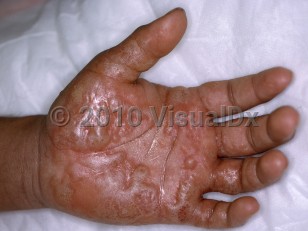Anhydrous Ammonia:
- Anhydrous ammonia is a colorless, pungent gas frequently used in agriculture as well as in the manufacture of synthetic fibers. Contact with water produces ammonium hydroxide.
- Upper airway symptoms include sore throat, nasal irritation with sneezing, and rhinorrhea.
- Gastrointestinal symptoms include nausea and vomiting.
- Cutaneous symptoms, depending on the concentration of the gas, include superficial to full-thickness burns with tissue loss, thrombosis, and necrosis.
- Respiratory symptoms include chest tightness, coughing, wheezing, tachycardia, pulmonary edema, airway obstruction from sloughed tissue, and respiratory arrest.
- Ocular symptoms include lacrimation, conjunctivitis, palpebral edema, blepharospasm, photophobia, ulceration, perforation, and loss of vision.
- Sulfur dioxide is a compressed gas that has industrial and commercial applications. Contact with moisture produces sulfurous acid.
- Upper airway symptoms include sore throat, nasal irritation with sneezing, and rhinorrhea.
- Gastrointestinal: nausea with vomiting.
- Cutaneous: chemical burns, especially in moist areas such as the axillae and groin.
- Respiratory: chest tightness, coughing, wheezing, dyspnea, tachycardia, pulmonary edema, cyanosis, and airway obstruction from sloughed tissue.
- Ocular: lacrimation, conjunctivitis, local edema, corneal damage, ulceration, perforation, and loss of sight.



